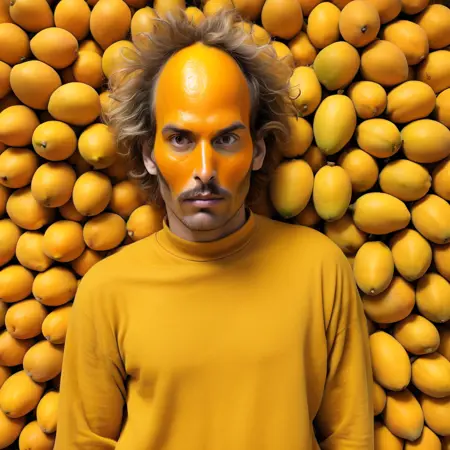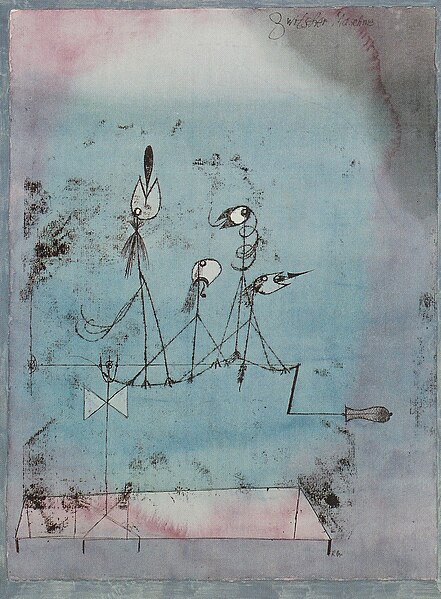Verified: 5 months ago
SafeTensor
The FLUX.1 [dev] Model is licensed by Black Forest Labs. Inc. under the FLUX.1 [dev] Non-Commercial License. Copyright Black Forest Labs. Inc.
IN NO EVENT SHALL BLACK FOREST LABS, INC. BE LIABLE FOR ANY CLAIM, DAMAGES OR OTHER LIABILITY, WHETHER IN AN ACTION OF CONTRACT, TORT OR OTHERWISE, ARISING FROM, OUT OF OR IN CONNECTION WITH USE OF THIS MODEL.
Art does not reproduce what we see. It makes us see. Art does not reproduce the visible; it makes visible – Paul Klee (18 December 1879 – 29 June 1940)
Trained on 42 images by the Swiss-born German painter Paul Klee. To see his works, please go to
I have to confess that I was aware of this innovative artist until last week. But some of his works are truly unique and spectacular. From Wikipedia:
His highly individual style was influenced by movements in art that included expressionism, cubism, and surrealism. Klee was a natural draftsman who experimented with and eventually deeply explored color theory, writing about it extensively; his lectures Writings on Form and Design Theory (Schriften zur Form und Gestaltungslehre), published in English as the Paul Klee Notebooks, are held to be as important for modern art as Leonardo da Vinci's A Treatise on Painting was for the Renaissance.[1][2][3]
Due to the highly abstract and diverse nature of his work, this LoRA is wild and unpredictable, but always interesting. I hope you'll be pleasantly surprised by what it can generate 😎🎈
From ChatGPT:
Paul Klee was a Swiss-German painter and one of the most influential figures in 20th-century modern art. Known for his playful yet deeply symbolic style, Klee’s work defied strict artistic categories, blending elements of Cubism, Expressionism, and Surrealism. He explored color theory extensively and developed a highly personal visual language marked by whimsical forms, intricate patterns, and symbolic motifs.
Early Life & Education
Born: December 18, 1879, in Münchenbuchsee, Switzerland.
Klee’s early interests included music, heavily influenced by his father, a professional violinist. This lifelong musical influence would later shape the rhythmic structure and harmony of colors in his paintings.
He studied at the Academy of Fine Arts in Munich, where he developed his foundational artistic skills.
Artistic Evolution & Style
Klee’s artistic journey evolved through distinct phases, with recurring themes of fantasy, symbolism, and abstraction.
1. Early Work (1900–1913): Precision and Satire
Early in his career, Klee created etchings, caricatures, and highly detailed ink drawings.
His early works often combined dark humor with social commentary.
2. Encounter with Color (1914): The Tunisia Trip
A turning point came in 1914 when Klee traveled to Tunisia. The vibrant colors and luminous light profoundly affected him.
He famously wrote: "Color has taken possession of me; no longer do I have to chase after it. I know that it has hold of me forever."
This experience led him to integrate brilliant color palettes into his work.
3. Bauhaus Period (1921–1931): Teaching and Experimentation
Klee joined the Bauhaus (a revolutionary German art school) where he taught for nearly a decade.
His teachings focused on color theory, geometry, and the relationship between line, form, and emotion.
His Bauhaus period works often feature abstract compositions, musical rhythms, and symbolic imagery.
4. Surrealist Influence & Later Works (1930s): Personal Symbolism
Klee’s later works are characterized by their dreamlike quality, using symbols, hieroglyphics, and childlike forms to convey deeper meanings.
During this time, his work grew increasingly introspective, reflecting themes of mortality, spirituality, and resilience as he faced political upheaval and declining health.
Notable Works
Senecio (1922) A striking portrait composed of geometric shapes and bold colors, resembling a mask or theatrical face.
Twittering Machine (1922) A surreal depiction of mechanical birds perched on a crankshaft, blending whimsy with a sense of unease.
Castle and Sun (1928) A vibrant yet abstract cityscape created from geometric forms, demonstrating Klee’s mastery of color and composition.
Ad Parnassum (1932) An intricate mosaic of tiny dots and blocks of color, symbolizing a harmonious meeting of music and visual art.
Key Themes in Klee’s Art
Music and Rhythm: As a trained violinist, Klee’s compositions often echo musical structure, with repeating patterns and harmonious color schemes.
Fantasy and Playfulness: Many of his works feature whimsical creatures, imaginative worlds, and childlike forms.
Symbolism and Mysticism: Klee developed his own visual language of arrows, eyes, spirals, and hieroglyphs, representing spiritual ideas and personal introspection.
Emotional Depth: While some works are lighthearted, others reflect darker themes, particularly in his later years as he battled illness and faced Nazi persecution.
Challenges and Later Life
In 1933, after the Nazis labeled his art as "degenerate", Klee fled Germany and returned to Switzerland.
In his final years, Klee suffered from scleroderma, a debilitating illness that influenced his work’s introspective tone. Despite his declining health, Klee remained productive, creating over 1,200 works in his final year.
He passed away in 1940 at the age of 60.







